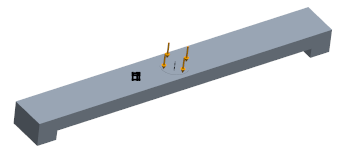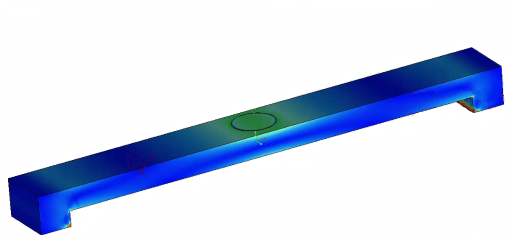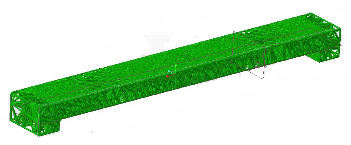To Create Stochastic Lattice with Varied Density Based on Creo Simulate Results
In this procedure, the results of a Creo Simulate study are used to construct stochastic lattice with varied density. The resulting lattice has higher density in regions of higher stress, and lower density in regions of lower stress. In stochastic lattice, the density is increased by increasing the number of the lattice cells.
A similar process also applies to beam-based lattice that is not stochastic. In beam-based lattice with a regular cell shape, in the resulting lattice, the density in regions of higher stress is increased by increasing the diameter of lattice beams and balls, and decreasing the diameter in areas of lower stress.
1. Open a part that contains a Creo Simulate study.
The study folder should already be saved with the part. The Creo Simulate study should already be run in the part or assembly, and the results should be saved in the part or assembly.
A Creo Simulate study folder is used for lattice creation. If the results were saved with the part, you should use the Creo Simulate folder that corresponds to the part, and if the results were saved with assembly, you should use the Creo Simulate folder that corresponds to the assembly.
|
|
A Creo Simulate study that was created in an assembly can be used to calculate lattice density under the following conditions:
• The study should only be used in an assembly context. If you try to use the assembly analysis results in a standalone part, the feature could fail.
• If you create lattice in an assembly context, using assembly simulation results, on a part, then regenerating the lattice in a standalone part will cause the lattice feature to fail, even if the assembly is in session.
|
2. Click the Applications tab, and then click Simulate. The loads and constraints defined in the study appear.

Higher resolution in AutoGEM control would result in a better quality of the lattice. |
3. To view the study results, click > to open the Simulate Results window, and then click  Open and browse to the results to open.
Open and browse to the results to open.
 Open and browse to the results to open.
Open and browse to the results to open.
The areas near the fixed constraints, at the bottom edges, are colored red, indicating areas of high stress. The blue areas indicate areas of low stress.
4. To return to the part environment, click the Model tab.
5. To create the lattice, click > .
6. To define the general parameters of the lattice:
◦ Click the Lattice Region tab, and select the Replace body with lattice check box.
◦ Click the Cell Type tab, and select  Stochastic.
Stochastic.
 Stochastic.
Stochastic.◦ Click the Cell Fill tab, and type values for the Ball diameter and Cross section size.
◦ Define other parameters as needed.
7. To defined the density parameters of the lattice:
a. Click the Density tab.
b. To use simulation results to define the lattice density, under Variability based on, select  Simulation.
Simulation.
 Simulation.
Simulation.c. To select the study that defines the density:
a. Click  . The Select Simulation Study Location dialog box opens.
. The Select Simulation Study Location dialog box opens.
 . The Select Simulation Study Location dialog box opens.
. The Select Simulation Study Location dialog box opens.b. Navigate to the folder that contains the study, and click OK. The study appears under Case name.
8. To define the density values for the resulting lattice, under Volume Fraction, define the following parameters:
◦ Min—Limits how sparsely the lattice cells can be constructed. A value of .05 means that in any region, the lattice must contain at least 5% of the mass of the original body.
◦ Average—Overall resulting mass percentage. A value of .4 will result in a lattice with an average of 40% of the mass of the original part.
◦ Max—Limits how densely the lattice can be constructed. A value of .95 means that in any region, the lattice cannot contain more than 95% of the mass of the original body.
9. To refresh the display of the minimum and maximum stress cutoff values, click  Refresh.
Refresh.
 Refresh.
Refresh.This option is available for stochastic lattice when the  OK command is available on the Lattice tab, or after clicking
OK command is available on the Lattice tab, or after clicking  preview for other beam-based lattice.
preview for other beam-based lattice.
 OK command is available on the Lattice tab, or after clicking
OK command is available on the Lattice tab, or after clicking  preview for other beam-based lattice.
preview for other beam-based lattice.10. On the Lattice tab, click  OK. The lattice is constructed. It is more dense in areas of greater stress, less dense in areas of lower stress, and the density varies gradually between the two.
OK. The lattice is constructed. It is more dense in areas of greater stress, less dense in areas of lower stress, and the density varies gradually between the two.
 OK. The lattice is constructed. It is more dense in areas of greater stress, less dense in areas of lower stress, and the density varies gradually between the two.
OK. The lattice is constructed. It is more dense in areas of greater stress, less dense in areas of lower stress, and the density varies gradually between the two.
 Simulate Results
Simulate Results Lattice
Lattice